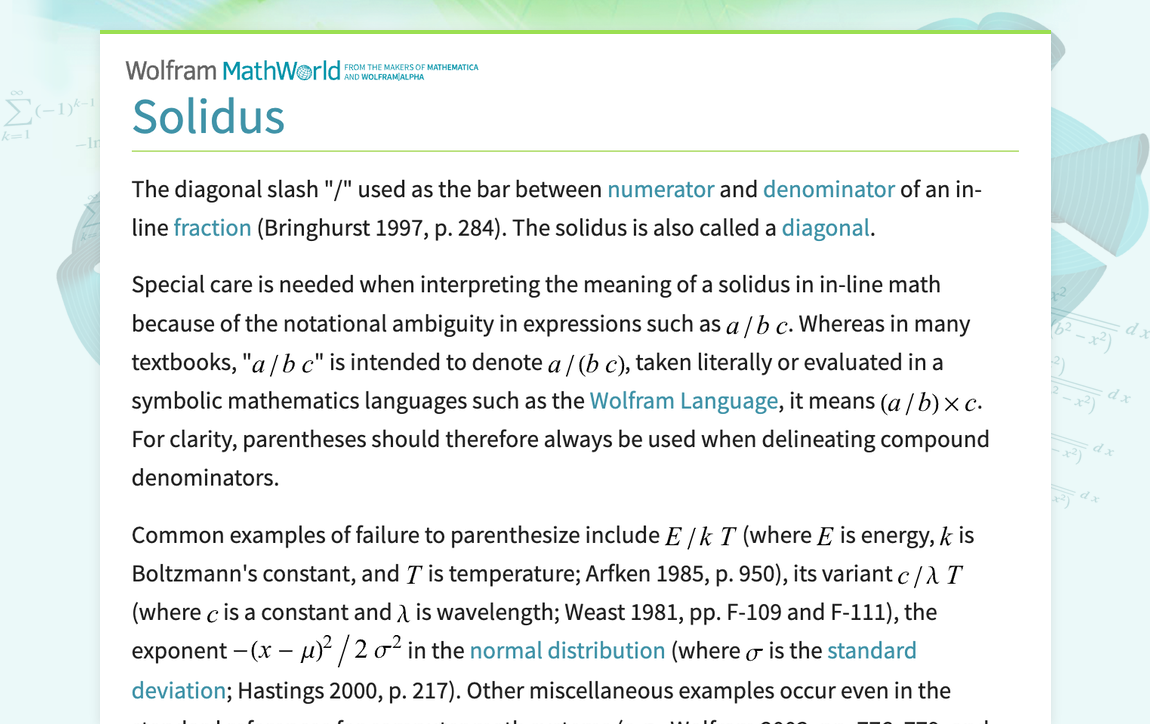What does…
- Thread starter 57stratdawg
- Start date
You are using an out of date browser. It may not display this or other websites correctly.
You should upgrade or use an alternative browser.
You should upgrade or use an alternative browser.
That depends:
Is this the same equation?
ETA: It's not spacing correctly when I post it.
Is this the same equation?
6
---------------
2(1+2)
---------------
2(1+2)
ETA: It's not spacing correctly when I post it.
My Dear Aunt Sally taught me this **** but it was a long time ago.
The answer is to all multiple questions is that "Missouri should not be in the SEC" if that is an option. Hell, it might be the answer as a write-in option. Just go to one football game in Columbia, Missouri - it ain't like all the rest of the conference, Vandy has an incredible game day atmosphere by comparison.
I just stuck it in my calculator. I am an engineer, I can't do math.
You'll have to Please Excuse her though....cause she's old.My Dear Aunt Sally taught me this **** but it was a long time ago.
That's so 20th CenturyMy Dear Aunt Sally taught me this **** but it was a long time ago.
They should drop Missouri and get Clemson.The answer is to all multiple questions is that "Missouri should not be in the SEC" if that is an option. Hell, it might be the answer as a write-in option. Just go to one football game in Columbia, Missouri - it ain't like all the rest of the conference, Vandy has an incredible game day atmosphere by comparison.
6 / 2(1+2) = 6 ÷ 2 * (1+2)
= 6 ÷ 2 * 3
= 3 * 3
= 9

= 6 ÷ 2 * 3
= 3 * 3
= 9

Solidus -- from Wolfram MathWorld
A solidus is a diagonal slash "/" used as the bar between numerator and denominator of an in-line fraction (Bringhurst 1997, p. 284). The solidus is also called a diagonal. Special care is needed when interpreting the meaning of a solidus in in-line math because of the notational ambiguity in...
mathworld.wolfram.com
It equals a total waste of my time.
Nope. PEMDAS only refers to calculating what is in the parentheses first, then then it is no different than 6/2*3You have to distribute the 2 to the parenthesis before dividing. This is included in PEMDAS
Engineer and son of a retired math teacher. This has been drilled into me for far too long.
See here: https://mindyourdecisions.com/blog/2016/08/31/what-is-6÷212-the-correct-answer-explained/
Having said all that, I still voted for Missouri to not be in the SEC.
I swear I was taught to figure out whatever is in parenthesis first, then figure out what is connected to the parenthesis, and then figure out the problem.6 / 2(1+2) = ?
So...
1+2= 3
2x3= 6
6/6=1
But its been a moment since I actually had to use any of this, so I guess that isnt how I was taught?
Whatever- I voted that Mizzou should go back to the Big12.
Whoever wrote that equation went to Missouri.
My understanding is that it's more like:That depends:
Is this the same equation?
6
---------------
2(1+2)
ETA: It's not spacing correctly when I post it.
6
___ * (1+2)
2
ETA: If he had included all of 2(1+2) in a second parentheses like 6/(2(1+2)), then it would have been what you described.
Last edited:
PEMDAS is a little misleading because it's more like:Shoutout PEMDAS
PE(M|D)(A|S)
Parenthesis then Exponent then Multiplication OR Division (L to R) then Addition OR Subtraction (L to R)
After what's in the parenthesis has been solved, it's just a regular number. If there's an operator (*/+-) before it, you follow the operator and its order within PE(MD)(AS). If there's no operator, you assume multiplication as if it had a * or X in front of it.I swear I was taught to figure out whatever is in parenthesis first, then figure out what is connected to the parenthesis, and then figure out the problem.
So...
1+2= 3
2x3= 6
6/6=1
But its been a moment since I actually had to use any of this, so I guess that isnt how I was taught?
Whatever- I voted that Mizzou should go back to the Big12.
I would agree with you but then we'd both be wrong. Distributing to the Parenthesis is part of the P in PEMDASNope. PEMDAS only refers to calculating what is in the parentheses first, then then it is no different than 6/2*3
Engineer and son of a retired math teacher. This has been drilled into me for far too long.
See here: https://mindyourdecisions.com/blog/2016/08/31/what-is-6÷212-the-correct-answer-explained/
Having said all that, I still voted for Missouri to not be in the SEC.
Answer is 9. Put it in any scientific calculator, you get 9.
The problem is, it's not an everyday application. That '/' is seldom used in this way, and I can't come up with any logical use for that equation. Most any time this would be used in real life, this would be shown as either a fraction, or with parentheses around the '2(2+1)'.
So, technical answer is 9, but it SHOULD be 1. Whole equation is just meant to confuse.
The problem is, it's not an everyday application. That '/' is seldom used in this way, and I can't come up with any logical use for that equation. Most any time this would be used in real life, this would be shown as either a fraction, or with parentheses around the '2(2+1)'.
So, technical answer is 9, but it SHOULD be 1. Whole equation is just meant to confuse.
I refuse to answer these types of questions on principle, because I'm a stickler for always using parentheses when there's any room for interpretation.6 / 2(1+2) = ?
Agreed, the problem is that it is a poorly written problem.I refuse to answer these types of questions on principle, because I'm a stickler for always using parentheses when there's any room for interpretation.
The main issue with this one is the implicit multiplication of the 2 and (1+2). There isn’t a universal standard and that is why you will get different answers. Some believe implicit multiplication should be resolved first, others say treat it like a multiplication sign. However, all of it could be solved by defining the problem better without using implicit multiplication.
There is a universal standard.Agreed, the problem is that it is a poorly written problem.
The main issue with this one is the implicit multiplication of the 2 and (1+2). There isn’t a universal standard and that is why you will get different answers. Some believe implicit multiplication should be resolved first, others say treat it like a multiplication sign. However, all of it could be solved by defining the problem better without using implicit multiplication.
I’d like to see some common core fans chime in….
6/2 = you decide
1+2 = lrrllllzzzlolol
Answer = go ahead and skip college
6/2 = you decide
1+2 = lrrllllzzzlolol
Answer = go ahead and skip college
Not when it comes to defining the priority between implicit and explicit multiplication.There is a universal standard.
“
Implied Multiplication and TI Calculators
...
Solution 11773: Implied Multiplication Versus Explicit Multiplication on TI Graphing Calculators.
Does implied multiplication and explicit multiplication have the same precedence on TI graphing calculators?
Implied multiplication has a higher priority than explicit multiplication to allow users to enter expressions, in the same manner as they would be written. For example, the TI-80, TI-81, TI-82, and TI-85 evaluate 1/2X as 1/(2*X), while other products may evaluate the same expression as 1/2*X from left to right. Without this feature, it would be necessary to group 2X in parentheses, something that is typically not done when writing the expression on paper.
This order of precedence was changed for the TI-83 family, TI-84 Plus family, TI-89 family, TI-92 Plus, Voyage™ 200 and the TI-Nspire™ Handheld in TI-84 Plus Mode. Implied and explicit multiplication are given the same priority.
This makes it clear that calculator designers have to decide on their own rules, which don’t have to be the same as rules for writing on paper; but educators seem to have convinced them to keep things as much the same as possible for students’ sake.
In conclusion (back to the 1999 answer):
So to answer your question, I think both answers can be considered right - which means, of course, that the question itself is wrong. I prefer the standard way (your first answer) when talking to students, unless their own text gives the "implicit multiplication first" rule; but in practice if I came across that expression, I would probably first check where it came from to see if I could tell what was intended. The main lesson to learn is not which rule to follow, but how to avoid ambiguity in what you write yourself. Don't give other people this kind of trouble.”
That is racist.6 / 2(1+2) = ?
Not when it comes to defining the priority between implicit and explicit multiplication.
“
Implied Multiplication and TI Calculators
...
Solution 11773: Implied Multiplication Versus Explicit Multiplication on TI Graphing Calculators.
Does implied multiplication and explicit multiplication have the same precedence on TI graphing calculators?
Implied multiplication has a higher priority than explicit multiplication to allow users to enter expressions, in the same manner as they would be written. For example, the TI-80, TI-81, TI-82, and TI-85 evaluate 1/2X as 1/(2*X), while other products may evaluate the same expression as 1/2*X from left to right. Without this feature, it would be necessary to group 2X in parentheses, something that is typically not done when writing the expression on paper.
This order of precedence was changed for the TI-83 family, TI-84 Plus family, TI-89 family, TI-92 Plus, Voyage™ 200 and the TI-Nspire™ Handheld in TI-84 Plus Mode. Implied and explicit multiplication are given the same priority.
This makes it clear that calculator designers have to decide on their own rules, which don’t have to be the same as rules for writing on paper; but educators seem to have convinced them to keep things as much the same as possible for students’ sake.
In conclusion (back to the 1999 answer):
So to answer your question, I think both answers can be considered right - which means, of course, that the question itself is wrong. I prefer the standard way (your first answer) when talking to students, unless their own text gives the "implicit multiplication first" rule; but in practice if I came across that expression, I would probably first check where it came from to see if I could tell what was intended. The main lesson to learn is not which rule to follow, but how to avoid ambiguity in what you write yourself. Don't give other people this kind of trouble.”

Since we are sometimes referred to as a”Cow College”, here is a cow math problem.
You have a pasture with a fence that makes a perfect circle when viewed from above. The enclosed area is exactly 1 acre (or any fixed area you want to use). If you prefer, you can select any diameter you want for the circle.
There is a cow in the pasture. One end of a rope is tied to a fence post on the perimeter of the pasture and the other end of the rope is tied to the cow’s collar.
How long does the rope need to be to allow the cow to graze exactly half the area of the pasture?
You have a pasture with a fence that makes a perfect circle when viewed from above. The enclosed area is exactly 1 acre (or any fixed area you want to use). If you prefer, you can select any diameter you want for the circle.
There is a cow in the pasture. One end of a rope is tied to a fence post on the perimeter of the pasture and the other end of the rope is tied to the cow’s collar.
How long does the rope need to be to allow the cow to graze exactly half the area of the pasture?
Not when it comes to defining the priority between implicit and explicit multiplication.
“
Implied Multiplication and TI Calculators
...
Solution 11773: Implied Multiplication Versus Explicit Multiplication on TI Graphing Calculators.
Does implied multiplication and explicit multiplication have the same precedence on TI graphing calculators?
Implied multiplication has a higher priority than explicit multiplication to allow users to enter expressions, in the same manner as they would be written. For example, the TI-80, TI-81, TI-82, and TI-85 evaluate 1/2X as 1/(2*X), while other products may evaluate the same expression as 1/2*X from left to right. Without this feature, it would be necessary to group 2X in parentheses, something that is typically not done when writing the expression on paper.
This order of precedence was changed for the TI-83 family, TI-84 Plus family, TI-89 family, TI-92 Plus, Voyage™ 200 and the TI-Nspire™ Handheld in TI-84 Plus Mode. Implied and explicit multiplication are given the same priority.
This makes it clear that calculator designers have to decide on their own rules, which don’t have to be the same as rules for writing on paper; but educators seem to have convinced them to keep things as much the same as possible for students’ sake.
In conclusion (back to the 1999 answer):
So to answer your question, I think both answers can be considered right - which means, of course, that the question itself is wrong. I prefer the standard way (your first answer) when talking to students, unless their own text gives the "implicit multiplication first" rule; but in practice if I came across that expression, I would probably first check where it came from to see if I could tell what was intended. The main lesson to learn is not which rule to follow, but how to avoid ambiguity in what you write yourself. Don't give other people this kind of trouble.”
On the other hand, Illicit Multiplication happens daily in Alabama.
Where is that taught? Show me a source. I sourced my argument. I have mathematicians that back me up. What about you?I would agree with you but then we'd both be wrong. Distributing to the Parenthesis is part of the P in PEMDAS
